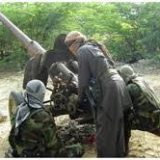As Power of Shabab Declines, Once Feared Fighters Leave Terror Group Behind
By ISMA’IL KUSHKUSH and JEFFREY GETTLEMAN
Tuesday, November 4, 2014
BAIDOA, Somalia (NY Times) — Bashir was a true believer, a foot soldier who recently quit after seeing too many innocents slaughtered.
Ahmed deserted the Shabab because he wanted a real family, not just a bunch of heavily armed, sociopathic militants who called themselves a “family,” he said.
And young Nurta was a slender assassin, with a bright purple scarf and wide, seemingly innocent eyes.
“There is no life with them,” said Nurta, who like other Shabab defectors requested that her last name not be used for fear of reprisals.
Even before its leader was cut down in an American airstrike in September, the Shabab militant group in Somalia, once one of Al Qaeda’s most powerful franchises, began unraveling. In the past few months, the group has been shedding territory — and fighters.
Dozens of defectors have been staying in a drab, one-story, heavily guarded concrete-block building in Baidoa, a scruffy town in central Somalia.
The picture they paint — in their accounts, and in their mere presence at a halfway house off the battlefield — is one of the Shabab in decline, without a charismatic leader, its ranks thinning, a once powerful organization now partly defanged, though still dangerous.
In early October, with African Union peacekeepers bearing down on them, Shabab fighters slunk away from one of the last strategically important cities the group controlled in Somalia, Barawe, an old port town on the threadbare southern coast. Residents said a column of Shabab battle wagons chugged off into the desert, splitting up into smaller groups that then disappeared in different directions.
Just a few years ago, the Shabab held much of southern Somalia in its brutal thrall. Shabab fighters chopped off heads, starved children, snatched up adolescent brides and stoned to death those girls who refused.
Until the advent of the Islamic State, or ISIS, in Iraq and Syria, the Shabab controlled more territory than any other Qaeda subgroup, bringing in millions of dollars by running ports and imposing taxes, which were used to bankroll terrorist attacks across the region.
The Shabab were seen as a cause — and effect — of Somalia’s years of chaos and one of the gravest threats to American interests in Africa. They were also considered a direct threat to the mainland United States. Several of their fighters, including some of the toughest, have been American citizens, able to fight in Somalia one day and potentially return to the United States the next.
But African Union peacekeepers, including Ugandans and Ethiopians, have dislodged Shabab fighters from all major towns in southern Somalia. The Somali population has decidedly turned against the Shabab.
In killing the Shabab’s leader, Ahmed Abdi Godane, the United States showed that after years of botched operations, it had finally cracked the group’s code, able to determine the exact location of the top militant in the country and kill him with minimal collateral damage.
But it also showed the deepening fractures in the Shabab’s organization: Analysts say the only way the Americans could have known where Mr. Godane was lurking was if someone in his inner circle had sold him out.
Since Mr. Godane’s replacement is a little-known fighter without much of a following, several Shabab defectors said that what little allure the group enjoyed was virtually gone. Some Shabab fighters have migrated north to the Galgala Mountains of Puntland, where they occasionally clash with local forces. Western intelligence officials estimate there are just a few thousand hardened Shabab fighters left.
Still, the Shabab might be like a poison: most dangerous when concentrated.
“The organization, in terms of its capacity, is still intact,” warned Afyare A. Elmi, a Somali professor at Qatar University.
He predicts that the militant group will continue to shed territory but “will keep up its guerrilla attacks and explosions.” Other analysts said the Shabab is actually getting more proficient in its assassinations, recently gunning down several Somali politicians.
As the Shabab showed last year, all it needs is a few die-hard followers to carry out deadly attacks. Four Shabab gunmen massacred dozens of civilians in a mall attack in Nairobi, Kenya, which still has the population there on edge.
At the “transition facility,” as the Somali government calls the drab Shabab halfway house in Baidoa, elders are pushing computer skills, carpentry and welding. The easiest way to de-radicalize former jihadists, the theory goes, is to give them jobs.
All of the former fighters said they felt hunted. Even in Baidoa, Shabab agents continue to slip in and out undetected.
Ahmed, 26, joined the Shabab four years ago because of the promises the group made.
“I didn’t have a job,” he said. “They told me you will get a lot of money, a bungalow and go to paradise.”
After fighting for the Shabab for three years, though, Ahmed never got his bungalow.
“No life, no family, no future,” he shook his head.
Noor, 29, another recent defector, was a member of a rival group when he was captured and forced to fight for the Shabab. He said they “conveyed the wrong message about Islam.”
“They placed heavy taxes on people,” he said. When he tried to argue, Shabab members beat him.
When Bashir, 24, first joined the Shabab, he believed in their ideas. He believed in holy war, he believed in a new Islamist Somalia, he believed in a rigid and decisive interpretation of Islamic law more than a thousand years old.
But when Mr. Godane took over the Shabab, around 2008, Bashir was no longer sure what he believed in.
Mr. Godane “allowed for the killing of innocent people. And I think he worked for elements from other countries, not for Somalia.”
“I am happy to hear he is dead,” Bashir said.
So is Nurta, the young female assassin. Her involvement with the Shabab was never a matter of choice. She was kidnapped, she said, by foreign fighters, white men, who snatched her from her school when she was 16. She was the perfect terrorist: a young woman who few might suspect of being a killer.
“I was trained to shoot targets in public areas, how to jump over buildings and target watch towers,” she said.
Nurta said she soon became an expert in the tools of death: AK-47s, sniper rifles, bombs, pistols of various make.
She said she was dispatched to the Kenyan coast in 2011 to help kidnap two foreigners, crimes that deeply hurt the country’s tourism industry and helped lead Kenya to later send troops into Somalia.
But at one point, she said, enough was enough. Nurta grew sick of seeing her colleagues’ cavalier disregard for human life.
Even when the Shabab’s own star fighters were wounded in battle, she said, “they didn’t care and left them to die.”
After defecting, Nurta went underground. But the Shabab were determined to find her. She knew too much.
Earlier this year, while she was in the market in Baidoa, she saw a Shabab assassin whom she knew. Their eyes locked. She tried to run as he pulled the pin on his grenade. The explosion floored her. Shrapnel sliced into her face. She survived, but shortly after that, the Shabab murdered her brother.
“I ask God to forgive me,” she said, the tears running down her scarred cheek.
In late September, right before the Shabab pulled out of Barawe, they marched a young woman into the middle of an open field. They buried her in the sand up to her neck. They smashed her brains with rocks.
They accused the woman of adultery, and the grisly execution seemed intended to send a simple but ineluctable message: The group is not done yet.
Isma’il Kushkush reported from Baidoa, and Jeffrey Gettleman from Nairobi, Kenya.




















